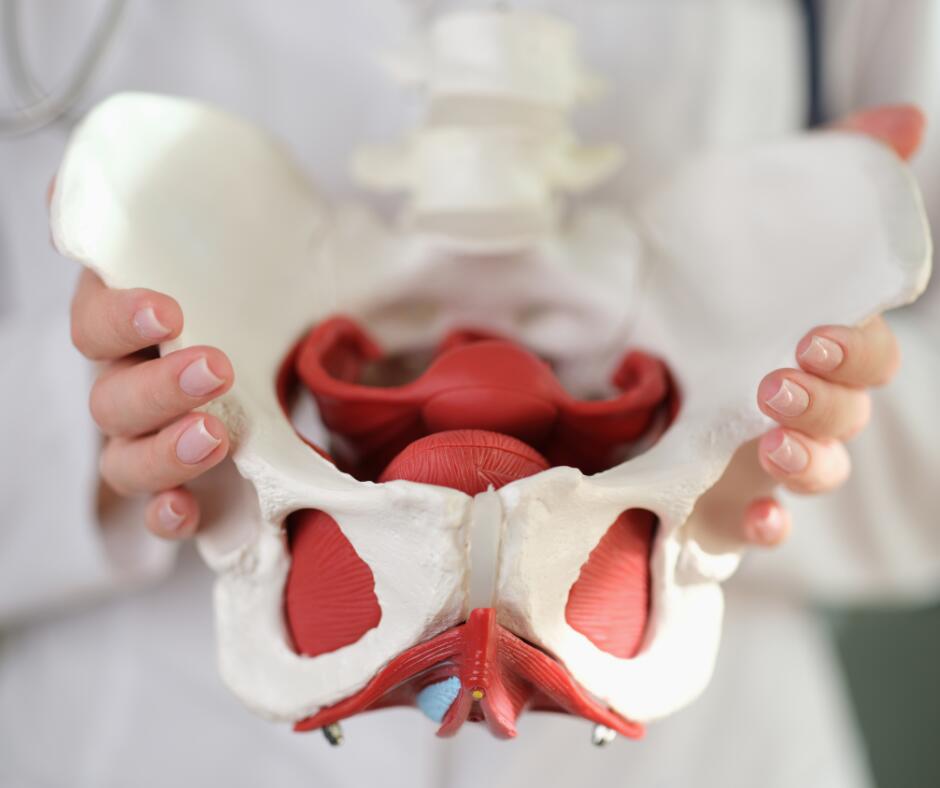Balance Your Pelvic Floor: Yoga Poses & Exercices
Regular exercise to connect the brain to the pelvic muscles will relieve menstrual pain, prevent pelvic discomfort and keep the genital area healthy. With their help, you can reduce the risk of injury during childbirth and recover faster. Training these muscles is one way to prevent them from wearing out after menopause. They support the visceral organs and are very important in recovering from inflammatory conditions of the small intestine and colon.
After giving birth or as you get older, you may notice that your pelvic muscles are not as strong. These are the muscles that support your bladder, bowel and uterus. When they contract, the organs are lifted and the openings to the vagina, anus and urethra tighten. When the muscles are relaxed, urine and feces can be eliminated from the body.
The pelvic muscles play an important role in sexual function. Keeping a balance between strength and flexibility in these muscles can reduce pain experienced during sex and increase the ability to feel pleasure. A good blood flow in the pelvic region is very important for fertility and reproductive health. During pregnancy, the pelvic muscles support the baby and also help with childbirth.
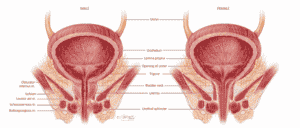
Pregnancy and childbirth can cause the muscles to weaken, but there are other factors that can affect the pelvic floor, such as age, obesity, heavy lifting and chronic coughing. An imbalance in the pelvic muscles, weakness or tension, can cause incontinence or pain during sex. They are a part of the “core muscles” and they should be considered in any exercise routine.
In this article, we will look at some exercises and yoga poses to do just that – balance your pelvic floor muscles, improve blood circulation, promote movement and relax the pelvic girdle. The Bound Angle Pose (Baddha Konasana), Legs-up-the-wall Pose (Viparita Karani), Seated Twist Pose (Ardha Matsyendrasana) and other asanas are very beneficial.
Let’s look at some postures and exercises in more detail.
Bound Angle Pose (Baddha Konasana)
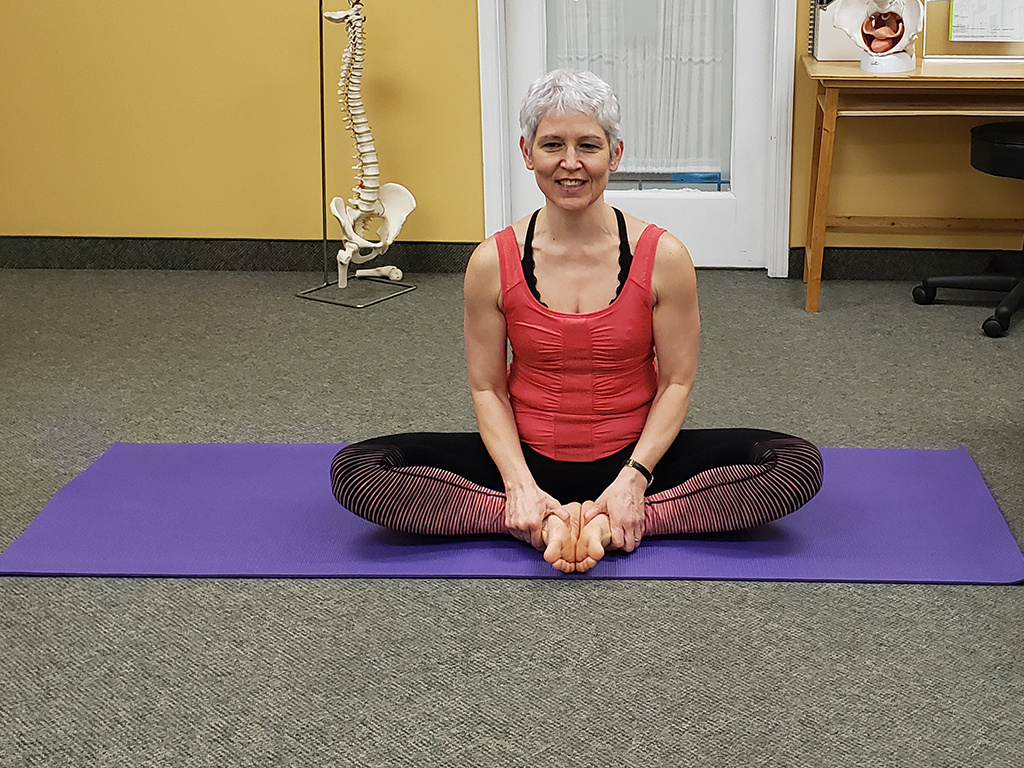
Baddha Konasana is especially useful for people suffering from diseases of the urinary tract. It heals the bladder and prostate gland in men and stimulates the ovaries in women.
Research shows that women who sit in Baddha Konasana for a few minutes every day during pregnancy did not experience as severe pain during childbirth due to stretching the inner thighs and groin and also avoided varicose veins.
This asana increases blood circulation in the pelvic region, stimulates the abdominal organs, tones the kidneys, relieves menopausal symptoms, menstrual pain and pain from sciatica. The pose is especially useful for those suffering from bladder problems.
Start by sitting with your legs stretched out directly in front of you. Then bend your knees and bring the soles of your feet together as you let your knees fall to either side. Draw your legs as close to your body as comfortable.
Press the outer edges of your legs firmly together. Your legs may begin to open like a book. You can encourage this with your hands or by holding on to your toes. Stand with a long spine, keeping your shoulder blades back and your shoulders away from your ears.
If your hips are tight, be sure to sit on a blanket or two to lift your backside. You’ll be surprised at how this trick allows you to sit up tighter with much more comfort.
Legs Up the Wall Pose (Viparita Karani)
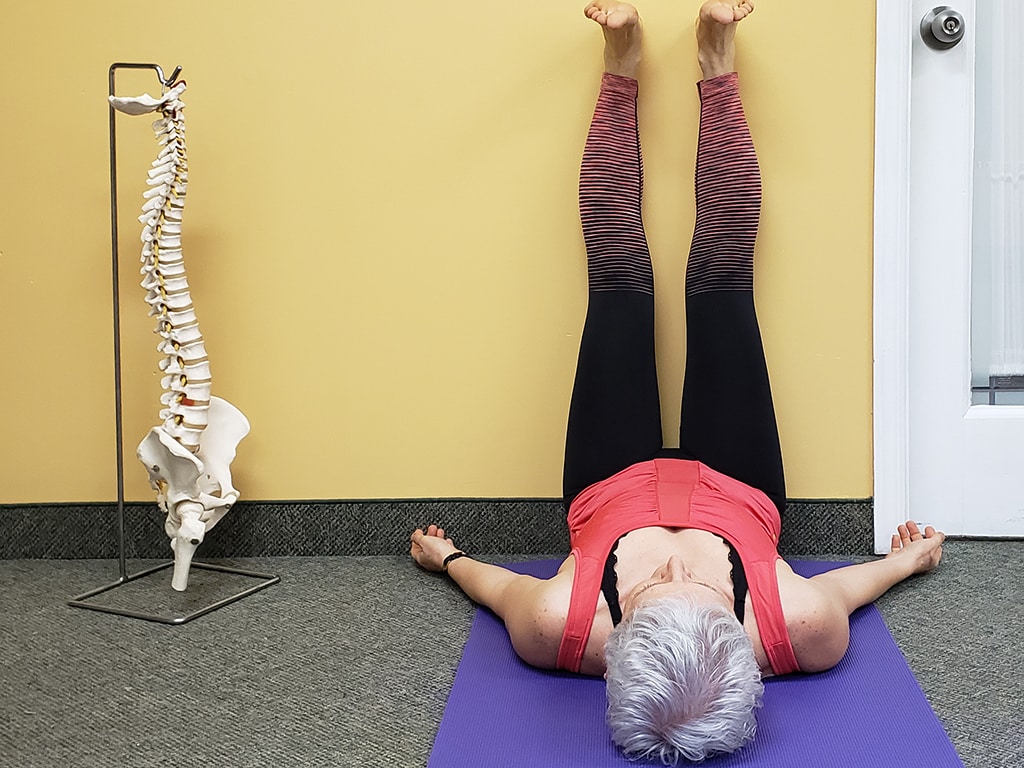
To understand how powerful this asana is, let’s take a closer look at what it contributes to:
The first and most important effect on the body is improved blood and lymph flow due to an inverted state. Also, due to the same condition, the brain and the pituitary gland in particular are actively enriched with blood, which contributes to the rejuvenation of the whole body.
The internal organs, especially the intestines, due to the attraction begin to sink into the diaphragm (which in the usual direct position appears exactly reversed). Thus, its additional stimulation is achieved: toxins happily leave the body. If at the same time practicing Viparita Karani additional breathing, then a quality massage of the abdominal area is guaranteed.
To begin with, find a good place next to a wall, then use an exercise mat and a support (cushion/blanket) which you place in the curve of your back to ensure the most balanced position. You can also perform this exercise in bed with your feet against the wall. Next, bring your hips as close to the wall as possible, then start climbing the wall until your body comes to stand roughly in an L position.
Try to touch the wall with your pelvic bones. Your heels should be lifted up and your upper torso should be placed on the ground in a relaxed position. Hands should be stretched out beside the body, palms facing upwards. Relax the abdominal muscles and extend the spine. Once you have achieved a stable and comfortable position, close your eyes and relax. Hold this posture for 10 minutes.
This posture has countless benefits, some of which include relaxing the pelvic area. The pelvic muscles unwind naturally in this position (even better with a pillow under the pelvic area), while also being a strengthening exercise for this area.
Seated Twist Pose (Ardha Matsyendrasana)
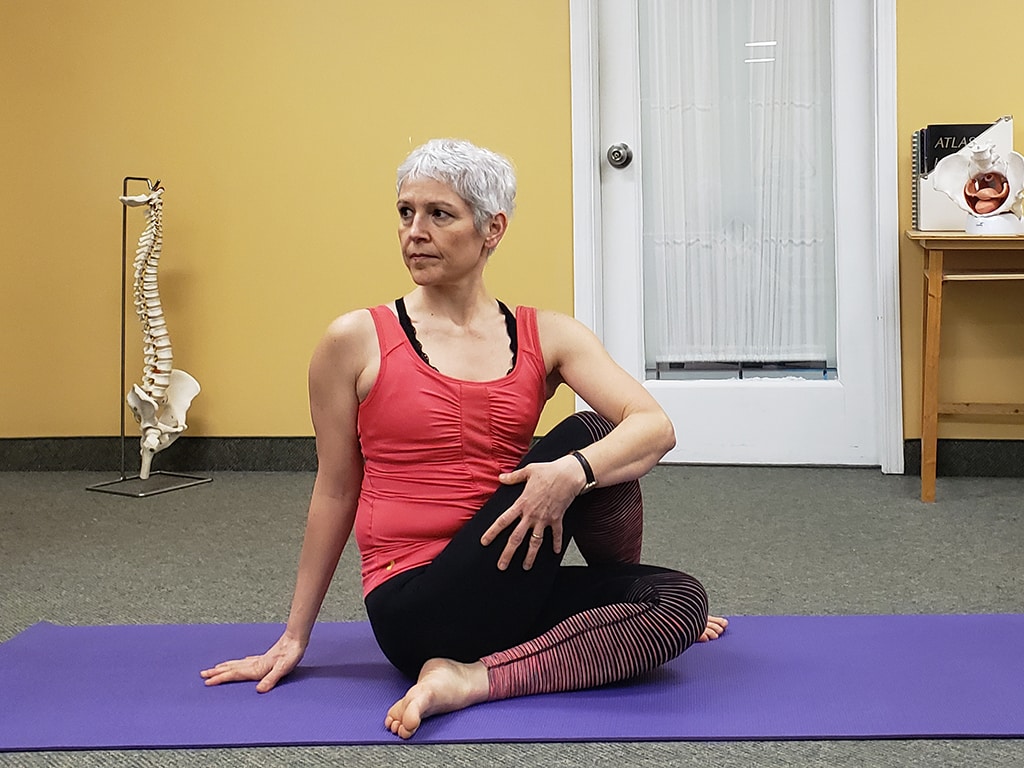
Ardha Matsyendrasana is a seated yoga pose that provides increased flexibility and movement in the muscles of the spine and back – also recommended for the entire back.
It can be a strenuous exercise. Breathe deeply and turn calmly to the side – don’t jerk, but rather move very calmly to the side. Hold the position for 7-8 deep breaths and then repeat on the other side.
If you have sciatica pain or severe back pain, then practicing this pose will ease your body in the long run. It is considered to be therapeutically effective for people with asthma problems and fertility disorders.
Many people may be aware that this asana also stimulates your kidneys and liver and helps your body function properly. Many women practice this yoga to tone their abdomen and improve flexibility in the pelvic region, as well as stretch the muscles of the back and spine and to relieve stiffness in the hip joints.
Reclining Bound Angle (Supta Baddha Konasana)
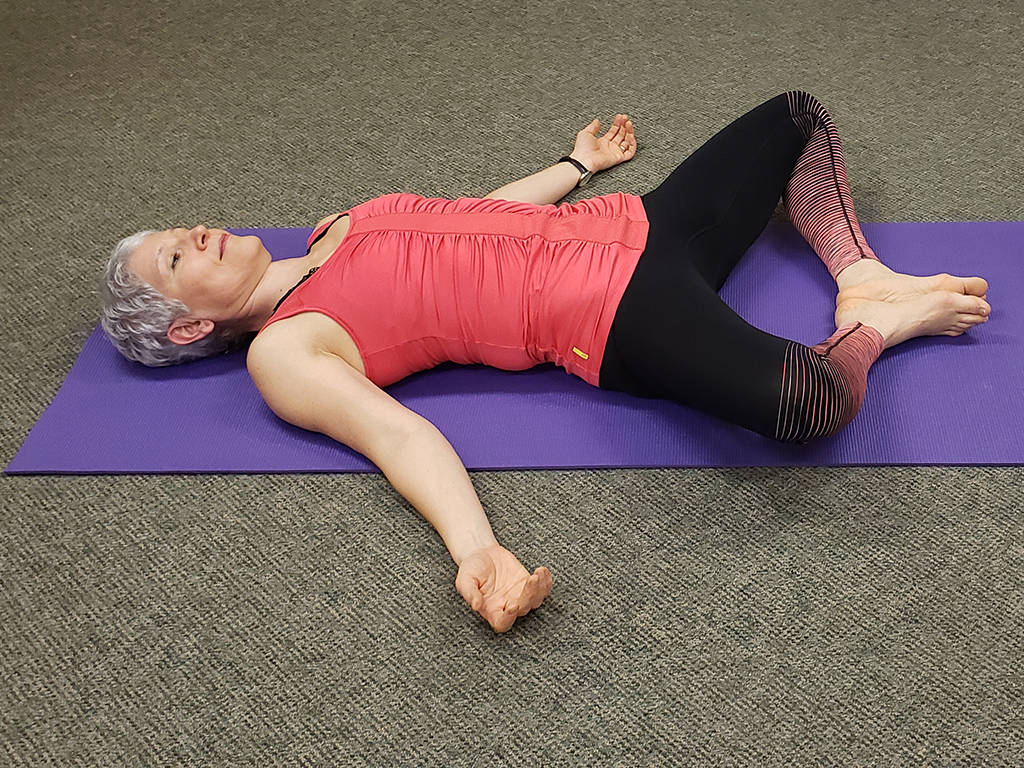
When you perform Supta Baddha Konasana, the lower abdomen softens, especially the pelvic and inner groin areas. The circulation of blood and lymph is normalized, improving the activity of the entire pelvic area. The asana is indicated for pregnant women and all those who intend to conceive a child.
Extend your hips and knees out to the sides, lowering them as far as possible to the floor. Try to put your knees in the pose to still reach the floor, don’t lift them up, this is a mistake. Flatten your chest and lift it up. Straighten your neck, lower your chin slightly, your back tail should point towards your legs: your lower back should not bend much.
Relax as much as possible, feel the stretch in the pelvic area. Perform Supta Baddha Konasana while breathing evenly. Exhale, relax even more, directing this relaxation to the pelvic area. Stay in the pose for one minute, gradually increase the length of stay in it to 10 minutes.
Exit the asana carefully: lift your knees, relax your groin, help yourself with your hands, to avoid a muscle spasm.
Half Pigeon Pose (Eka Pada Rajakapotasana)

The Pigeon Pose is one of the most popular yoga poses. It is used to relax the hips and lower back, as well as to access and release emotional tension.
Your hips are a complex group of strong muscles, tendons and ligaments that are essential to your ability to move. Sitting in front of the computer all day prevents your hips from getting the movement and stretch they need. Activities such as running, walking and cycling develop strength in your hips, but don’t bend and stretch them and they can become more strained. Stress is also a major contributing factor to tight hips, as we tend to have tension in this area. Eliminate tense hips by integrating one-legged posture, or eka pada rajakapotasana, to your yoga or exercise routine.
Sit with your legs crossed and palms flat on the ground. While keeping your left leg bent, try stretching your right leg back until it is (almost) perpendicular to your left leg. Hold the position for 5-10 breaths, then switch sides and do as many repetitions as you like.
Among the most important benefits of the Pigeon Pose are increased hip mobility, calming the nervous system and relaxing the body, accessing the psoas muscle, often responsible for back pain, and releasing tension in the hip muscle tissues which brings with it the release of negative emotions and pent-up stress.
Book an Evaluation Appointment
If you have pain or discomfort even after doing the recommended exercises, book an evaluation appointment with Azita to work on your alignment, release stress and tension from affected areas and come up with a complete plan depending on your precise needs – improve fertility, prevent and treat back pain during and following pregnancy, prepare for labor, etc.
Azita Papaie is a registered physiotherapist passionate about the holistic approach to human body, health and well-being based in Saint-Henri, in Montreal.

